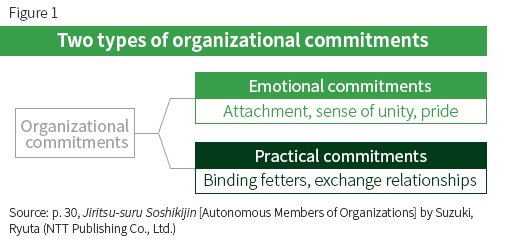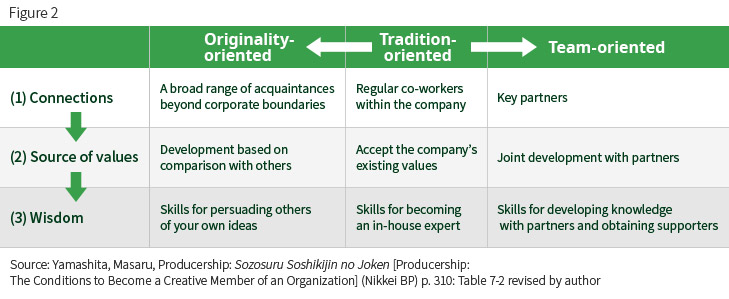Many people work for a corporation as its employee, and in return receive a salary as their livelihood. Until now, Japanese companies have been competing in the global market by transforming the competence of their employees into organizational capacity. However, many of the high-powered companies have been losing strength, and the relationship between Japanese corporations and their employees is about to reach a significant turning point.
First of all, let’s look back on the age when Japanese corporations were enjoying their greatest strength and grandeur. To be specific, I would say the period started at the beginning of the high economic growth era and went on until the bubble economy began to set in.
This age can be described as a period when corporations were magnets for people who endorsed their leaders’ corporate philosophy and values. Japan being a war-defeated nation, most Japanese people were unable to hold hope or values that they could be guided by. This is why they were attracted to business founders who upheld a clear vision as to how their company should be or business leaders with a strong determination to restore Japan, and sought to share in their values by becoming their employees. By sharing their leaders’ philosophy and aspiration, the employees unified their efforts to empower the company they worked for. The “tap water philosophy” advocated by Konosuke Matsushita is a well-known example of the strong aspirations of business leaders that attracted followers.
Under the flag of their business leaders’ philosophy, Japanese corporations at the time divided and further subdivided their labor among their employees to achieve the highest efficiency, and each employee worked hard to fulfill their own role. Such efforts naturally made the corporations stronger, and they achieved growth in leaps and bounds. In return for their employees’ labor, the companies offered them not only their salaries, but also a sense of attachment and pride toward the company they worked for as well as values they could share in. Each individual strongly identified with the company they worked for, and this fostered a culture of putting the company and work before anything else in life, leading to the creation of the so-called kaisha ningen, or “company man.” The connotation of kaisha ningen at the time was by no means negative.
When discussing the relationship between an organization and its individual members, the terms “exchange relationship” and “integrative relationship” are often used. The most straightforward “exchange relationship” is when an employee performs labor for a company and the company pays remuneration in return. This relationship presupposes that the values upheld by the company and the individual are different. However, in those days in Japan, companies and their employees were aligned in the same direction, forging a so-called “integrative relationship.” In this type of relationship, even though a reasonable amount of remuneration is paid, more emphasis is placed on sharing values. At the time, both sides were content with this arrangement.

When Japanese society became increasingly prosperous, just before the beginning of the bubble economy, individuals began to work based on their own diversified values. People were heard to say, “The president of my company says so and so, but that’s not what I value,” or “I’m working for this company just to earn money. What I really want to do is something else,” and so forth. They all had different reasons for working. It was also around this time that the lifetime employment system, where employees work for the same company from when they are employed straight out of university until retirement, began to erode.
The “integrative relationship” that had existed between corporations and individuals was no longer viable. Individuals were increasingly forging an “exchange relationship” with the company they worked for, meaning that they were merely affiliated with the company for their own benefit and not because they felt a sense of attachment to it.
Then, the bubble burst. As many companies lost their strength and were unable to generate profits, the annual pay raise could no longer be given. Even worse, pay packets had to be reduced. It was also becoming impossible to manage employees’ careers based on the seniority system of promotion. Thus, the remuneration paid by companies decreased, which prompted employees to seek employment elsewhere in a quest for the pay they desired.
Meanwhile, corporations began to introduce Western merit-based pay to cut down on their personnel expenses. They strived to retain high-caliber employees by paying them more and mercilessly cut lower performers who fell short of their expectations.
However, adoption of the merit-based system led to the further weakening of Japanese companies. This was because the adoption of the system was poorly executed and only went halfway.
In the merit-based system adopted by Japanese companies, even if a young employee were to achieve an immense accomplishment, he or she would rarely get promoted across hierarchical boundaries to an executive director position or receive huge amounts of remuneration. The most this person could hope for was to be promoted to the highest position among his or her peers who joined the company in the same year. The Japanese merit-based system was thus a merit-based system among peers of the same age, and adoption of this system corroded the tight-knit horizontal bonds among them.
The hiring system in Japan is a unique one in which new university graduates are all recruited at the same time, once a year in spring. This system of annual recruitment used to foster strong bonds among peer employees hired in the same year. As expressed by the classic Japanese phrase, “sharing rice cooked in the same pot,” same-age peers forged a unique and cohesive camaraderie among themselves. This practice had been highly effective for Japanese corporations because same-age peers were both rivals to compete against and friends who encouraged and consoled each other. While cooperating, they would aspire to keep abreast of one another and compete to achieve results. A very popular TV show entitled Hanzawa Naoki depicted the typical bond formed between such same-age peers in a Japanese bank.
When the merit-based system was adopted, intense rivalry among peers became conspicuous, dispelling the favorable old practice of providing mutual support. Consequently, the sense of unity that had existed among employees and the ideal rivalry that used to provide positive stimulation at work were lost.
Now that the integrative relationship between corporations and individuals has collapsed, Japanese businesses are deprived of their source of strength. The sense of unity fostered among employees has vanished, and their shared values have fallen apart. In such circumstances, what kind of relationship should Japanese corporations forge with their employees to regain the strength they once enjoyed? Now, a new style of organization that matches the Japanese corporate culture is called for.
Corporations generally used the top-down approach to get things done rationally and efficiently, but the precondition for this is that values are shared with their employees. Shared values no longer exist today, so a simple top-down approach will not produce the high performance that it used to.
So what should companies do? In my opinion, the key to a good relationship between corporations and employees lies in how creatively employees can work and how creatively corporations can get their employees to work.
To start with, companies need to accept their employees’ diverse values, including in relation to how they want to work.
Individuals, at the same time, should unleash and express their creative ideas without hesitation. What you perceive as an “original” idea is often merely a second-hand notion. At work, people should try to acquire truly unique ways of thinking that make them different from others and pursue creativity.
It may be difficult to be original and creative at first, so I recommend that the following two-step approach be taken to explore one’s own style.

To start with:
I refer to this stage as the “tradition-oriented style,” which has been fostered by many Japanese companies. This is a systematic style that emphasizes work efficiency. When workers think that they have acquired this style, they should, at some point in time:
This is the stage where original and imaginative ideas are produced. There are two patterns for “taking a new step.”
One is the “originality-oriented style” and the other is the “team-oriented style.” The former style of career building is often pursued by people who are capable of engaging in creative work on their own. Individuals working in this style can do everything by themselves, including coming up with new ideas and finding sponsors for them. They are suited to launching venture firms.
The team-oriented style of career building is suitable for people who like to build rapport with others across the boundaries of organizational divisions and sections and create a team for producing new ideas and projects. Team members bounce their ideas off and inspire one another to proactively push forward and create new value.
Going forward, companies should value and foster people who take on the team-oriented style. These individuals form so-called informal organizations that do not fit into the formal organization chart. Some informal organizations in the past have been unproductive, as in groups that get together at bars and complain about their company. Most companies deem human nature to be fundamentally evil, and therefore have not perceived informal organizations in a positive light. However, going forward, it will be some of the informal organizations that will serve as a major driving force for companies.
On one hand, people taking on the originality-oriented style are capable of cutting their own path forward, and inasmuch as they have abundant ideas, they tend to leave their organization and go independent, creating no profit for the company. On the other hand, team-oriented employees can only work on intriguing and innovative ideas when they are with their teammates, which means, to a certain extent, that they are preconditioned to stay at their company. It is rare for an entire team to quit. Top management members should identify these team-oriented employees and provide them with time, funding and special privileges to help them perform well. By doing so, breakthroughs can be achieved. In this sense, companies should be cautious about implementing excessive internal control.
I cannot help but believe that in Japanese society, it will become important to establish organizational structures where corporations and their employees support each other and develop together. I assume that one way for corporations to survive the coming age will be to nurture with a broad mindset, rather than destroy, individuals and informal organizations with budding creativity.
(This column is as of 2015.)